Entry Database : PDB / ID : 4csjTitle The discovery of potent selective glucocorticoid receptor modulators, suitable for inhalation GLUCOCORTICOID RECEPTOR NUCLEAR RECEPTOR COACTIVATOR 2 Keywords / / / Function / homology Function Domain/homology Component
/ / / / / / / / / / / / / / / / / / / / / / / / / / / / / / / / / / / / / / / / / / / / / / / / / / / / / / / / / / / / / / / / / / / / / / / / / / / / / / / / / / / / / / / / / / / / / / / / / / / / / / / / / / / / / / / / / / / / / / / / / / / / / / / / / / / / / / / / / / / / / / / / / / / / / / / / / / / / / / / Biological species HOMO SAPIENS (human)Method / / / Resolution : 2.3 Å Authors Edman, K. / Ahlgren, R. / Bengtsson, M. / Bladh, H. / Backstrom, S. / Dahmen, J. / Henriksson, K. / Hillertz, P. / Hulikal, V. / Jerre, A. ...Edman, K. / Ahlgren, R. / Bengtsson, M. / Bladh, H. / Backstrom, S. / Dahmen, J. / Henriksson, K. / Hillertz, P. / Hulikal, V. / Jerre, A. / Kinchin, L. / Kase, C. / Lepisto, M. / Mile, I. / Nilsson, S. / Smailagic, A. / Taylor, J. / Tjornebo, A. / Wissler, L. / Hansson, T. Journal : Bioorg.Med.Chem.Lett. / Year : 2014Title : The Discovery of Potent and Selective Non-Steroidal Glucocorticoid Receptor Modulators, Suitable for Inhalation.Authors: Edman, K. / Ahlgren, R. / Bengtsson, M. / Bladh, H. / Backstrom, S. / Dahmen, J. / Henriksson, K. / Hillertz, P. / Hulikal, V. / Jerre, A. / Kinchin, L. / Kase, C. / Lepisto, M. / Mile, I. / ... Authors : Edman, K. / Ahlgren, R. / Bengtsson, M. / Bladh, H. / Backstrom, S. / Dahmen, J. / Henriksson, K. / Hillertz, P. / Hulikal, V. / Jerre, A. / Kinchin, L. / Kase, C. / Lepisto, M. / Mile, I. / Nilsson, S. / Smailagic, A. / Taylor, J. / Tjornebo, A. / Wissler, L. / Hansson, T. History Deposition Mar 7, 2014 Deposition site / Processing site Revision 1.0 May 7, 2014 Provider / Type Revision 1.1 May 21, 2014 Group Revision 1.2 Dec 20, 2023 Group Data collection / Database references ... Data collection / Database references / Derived calculations / Other / Refinement description Category chem_comp_atom / chem_comp_bond ... chem_comp_atom / chem_comp_bond / database_2 / pdbx_database_status / pdbx_initial_refinement_model / struct_site Item _database_2.pdbx_DOI / _database_2.pdbx_database_accession ... _database_2.pdbx_DOI / _database_2.pdbx_database_accession / _pdbx_database_status.status_code_sf / _struct_site.pdbx_auth_asym_id / _struct_site.pdbx_auth_comp_id / _struct_site.pdbx_auth_seq_id
Show all Show less
 Yorodumi
Yorodumi Open data
Open data Basic information
Basic information Components
Components Keywords
Keywords SIGNALING PROTEIN /
SIGNALING PROTEIN /  NUCLEAR HORMONE RECEPTOR /
NUCLEAR HORMONE RECEPTOR /  LIGAND COMPLEX /
LIGAND COMPLEX /  PEPTIDE COMPLEX
PEPTIDE COMPLEX Function and homology information
Function and homology information steroid hormone binding / PTK6 Expression / glucocorticoid metabolic process / neuroinflammatory response / microglia differentiation /
steroid hormone binding / PTK6 Expression / glucocorticoid metabolic process / neuroinflammatory response / microglia differentiation /  maternal behavior / mammary gland duct morphogenesis ...Regulation of NPAS4 gene transcription / regulation of glucocorticoid biosynthetic process / nuclear glucocorticoid receptor activity /
maternal behavior / mammary gland duct morphogenesis ...Regulation of NPAS4 gene transcription / regulation of glucocorticoid biosynthetic process / nuclear glucocorticoid receptor activity /  steroid hormone binding / PTK6 Expression / glucocorticoid metabolic process / neuroinflammatory response / microglia differentiation /
steroid hormone binding / PTK6 Expression / glucocorticoid metabolic process / neuroinflammatory response / microglia differentiation /  maternal behavior / mammary gland duct morphogenesis / nucleus localization / astrocyte differentiation / cellular response to glucocorticoid stimulus /
maternal behavior / mammary gland duct morphogenesis / nucleus localization / astrocyte differentiation / cellular response to glucocorticoid stimulus /  motor behavior /
motor behavior /  regulation of gluconeogenesis / adrenal gland development / RNA polymerase II intronic transcription regulatory region sequence-specific DNA binding / cellular response to steroid hormone stimulus / locomotor rhythm /
regulation of gluconeogenesis / adrenal gland development / RNA polymerase II intronic transcription regulatory region sequence-specific DNA binding / cellular response to steroid hormone stimulus / locomotor rhythm /  aryl hydrocarbon receptor binding / regulation of lipid metabolic process / cellular response to Thyroglobulin triiodothyronine / regulation of glucose metabolic process / Synthesis of bile acids and bile salts / Endogenous sterols / Synthesis of bile acids and bile salts via 27-hydroxycholesterol /
aryl hydrocarbon receptor binding / regulation of lipid metabolic process / cellular response to Thyroglobulin triiodothyronine / regulation of glucose metabolic process / Synthesis of bile acids and bile salts / Endogenous sterols / Synthesis of bile acids and bile salts via 27-hydroxycholesterol /  estrogen response element binding / FOXO-mediated transcription of oxidative stress, metabolic and neuronal genes / Synthesis of bile acids and bile salts via 7alpha-hydroxycholesterol / intracellular steroid hormone receptor signaling pathway / core promoter sequence-specific DNA binding / Recycling of bile acids and salts / regulation of cellular response to insulin stimulus / cellular response to hormone stimulus / cellular response to transforming growth factor beta stimulus / positive regulation of adipose tissue development / HSP90 chaperone cycle for steroid hormone receptors (SHR) in the presence of ligand / peroxisome proliferator activated receptor signaling pathway / RORA activates gene expression / TBP-class protein binding / Regulation of lipid metabolism by PPARalpha /
estrogen response element binding / FOXO-mediated transcription of oxidative stress, metabolic and neuronal genes / Synthesis of bile acids and bile salts via 7alpha-hydroxycholesterol / intracellular steroid hormone receptor signaling pathway / core promoter sequence-specific DNA binding / Recycling of bile acids and salts / regulation of cellular response to insulin stimulus / cellular response to hormone stimulus / cellular response to transforming growth factor beta stimulus / positive regulation of adipose tissue development / HSP90 chaperone cycle for steroid hormone receptors (SHR) in the presence of ligand / peroxisome proliferator activated receptor signaling pathway / RORA activates gene expression / TBP-class protein binding / Regulation of lipid metabolism by PPARalpha /  steroid binding / cellular response to dexamethasone stimulus / BMAL1:CLOCK,NPAS2 activates circadian gene expression / nuclear receptor coactivator activity / SUMOylation of transcription cofactors / Activation of gene expression by SREBF (SREBP) / response to progesterone /
steroid binding / cellular response to dexamethasone stimulus / BMAL1:CLOCK,NPAS2 activates circadian gene expression / nuclear receptor coactivator activity / SUMOylation of transcription cofactors / Activation of gene expression by SREBF (SREBP) / response to progesterone /  synaptic transmission, glutamatergic /
synaptic transmission, glutamatergic /  chromosome segregation /
chromosome segregation /  nuclear receptor binding / RNA polymerase II transcription regulatory region sequence-specific DNA binding /
nuclear receptor binding / RNA polymerase II transcription regulatory region sequence-specific DNA binding /  Hsp90 protein binding / circadian regulation of gene expression / Heme signaling / SUMOylation of intracellular receptors / mRNA transcription by RNA polymerase II / Activated PKN1 stimulates transcription of AR (androgen receptor) regulated genes KLK2 and KLK3 / Transcriptional activation of mitochondrial biogenesis / PPARA activates gene expression / Cytoprotection by HMOX1 / spindle / DNA-binding transcription repressor activity, RNA polymerase II-specific / Transcriptional regulation of white adipocyte differentiation / positive regulation of miRNA transcription / Nuclear Receptor transcription pathway / RNA polymerase II transcription regulator complex / positive regulation of neuron apoptotic process / Regulation of RUNX2 expression and activity /
Hsp90 protein binding / circadian regulation of gene expression / Heme signaling / SUMOylation of intracellular receptors / mRNA transcription by RNA polymerase II / Activated PKN1 stimulates transcription of AR (androgen receptor) regulated genes KLK2 and KLK3 / Transcriptional activation of mitochondrial biogenesis / PPARA activates gene expression / Cytoprotection by HMOX1 / spindle / DNA-binding transcription repressor activity, RNA polymerase II-specific / Transcriptional regulation of white adipocyte differentiation / positive regulation of miRNA transcription / Nuclear Receptor transcription pathway / RNA polymerase II transcription regulator complex / positive regulation of neuron apoptotic process / Regulation of RUNX2 expression and activity /  nuclear receptor activity /
nuclear receptor activity /  Circadian Clock / sequence-specific double-stranded DNA binding /
Circadian Clock / sequence-specific double-stranded DNA binding /  gene expression / chromatin organization / HATs acetylate histones / DNA-binding transcription activator activity, RNA polymerase II-specific / Estrogen-dependent gene expression /
gene expression / chromatin organization / HATs acetylate histones / DNA-binding transcription activator activity, RNA polymerase II-specific / Estrogen-dependent gene expression /  transcription regulator complex / Potential therapeutics for SARS /
transcription regulator complex / Potential therapeutics for SARS /  transcription coactivator activity /
transcription coactivator activity /  protein dimerization activity /
protein dimerization activity /  nuclear body / DNA-binding transcription factor activity, RNA polymerase II-specific /
nuclear body / DNA-binding transcription factor activity, RNA polymerase II-specific /  mitochondrial matrix / nuclear speck / RNA polymerase II cis-regulatory region sequence-specific DNA binding / DNA-binding transcription factor activity /
mitochondrial matrix / nuclear speck / RNA polymerase II cis-regulatory region sequence-specific DNA binding / DNA-binding transcription factor activity /  cell division / protein domain specific binding /
cell division / protein domain specific binding /  centrosome / negative regulation of DNA-templated transcription /
centrosome / negative regulation of DNA-templated transcription /  synapse / apoptotic process /
synapse / apoptotic process /  chromatin binding /
chromatin binding /  chromatin / regulation of DNA-templated transcription / regulation of transcription by RNA polymerase II /
chromatin / regulation of DNA-templated transcription / regulation of transcription by RNA polymerase II /  protein kinase binding / negative regulation of transcription by RNA polymerase II /
protein kinase binding / negative regulation of transcription by RNA polymerase II /  signal transduction
signal transduction
 HOMO SAPIENS (human)
HOMO SAPIENS (human) X-RAY DIFFRACTION /
X-RAY DIFFRACTION /  SYNCHROTRON /
SYNCHROTRON /  MOLECULAR REPLACEMENT / Resolution: 2.3 Å
MOLECULAR REPLACEMENT / Resolution: 2.3 Å  Authors
Authors Citation
Citation Journal: Bioorg.Med.Chem.Lett. / Year: 2014
Journal: Bioorg.Med.Chem.Lett. / Year: 2014 Structure visualization
Structure visualization Molmil
Molmil Jmol/JSmol
Jmol/JSmol Downloads & links
Downloads & links Download
Download 4csj.cif.gz
4csj.cif.gz PDBx/mmCIF format
PDBx/mmCIF format pdb4csj.ent.gz
pdb4csj.ent.gz PDB format
PDB format 4csj.json.gz
4csj.json.gz PDBx/mmJSON format
PDBx/mmJSON format Other downloads
Other downloads https://data.pdbj.org/pub/pdb/validation_reports/cs/4csj
https://data.pdbj.org/pub/pdb/validation_reports/cs/4csj ftp://data.pdbj.org/pub/pdb/validation_reports/cs/4csj
ftp://data.pdbj.org/pub/pdb/validation_reports/cs/4csj
 Links
Links Assembly
Assembly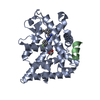
 Components
Components / GR / NUCLEAR RECEPTOR SUBFAMILY 3 GROUP C MEMBER 1
/ GR / NUCLEAR RECEPTOR SUBFAMILY 3 GROUP C MEMBER 1
 HOMO SAPIENS (human) / Plasmid: PFASTBAC1 / Production host:
HOMO SAPIENS (human) / Plasmid: PFASTBAC1 / Production host: 
 TRICHOPLUSIA NI (cabbage looper) / References: UniProt: P04150
TRICHOPLUSIA NI (cabbage looper) / References: UniProt: P04150

 HOMO SAPIENS (human) / Plasmid: PFASTBAC1 / Production host:
HOMO SAPIENS (human) / Plasmid: PFASTBAC1 / Production host: 
 TRICHOPLUSIA NI (cabbage looper) / References: UniProt: E7EWM1, UniProt: Q15596*PLUS
TRICHOPLUSIA NI (cabbage looper) / References: UniProt: E7EWM1, UniProt: Q15596*PLUS Ethylene glycol
Ethylene glycol Water
Water X-RAY DIFFRACTION / Number of used crystals: 1
X-RAY DIFFRACTION / Number of used crystals: 1  Sample preparation
Sample preparation
 SYNCHROTRON / Site:
SYNCHROTRON / Site:  ESRF
ESRF  / Beamline: ID29 / Wavelength: 0.98
/ Beamline: ID29 / Wavelength: 0.98  : 0.98 Å / Relative weight: 1
: 0.98 Å / Relative weight: 1  Processing
Processing :
:  MOLECULAR REPLACEMENT
MOLECULAR REPLACEMENT Movie
Movie Controller
Controller


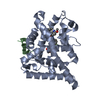

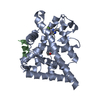
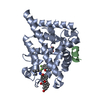
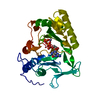
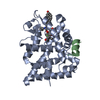
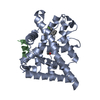

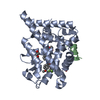
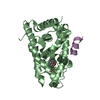
 PDBj
PDBj





















